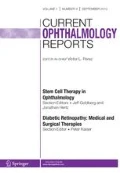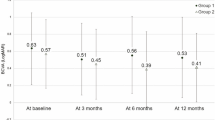Abstract
Purpose of Review
The aim of this review is to summarize developments in the treatment of active polypoidal choroidal vasculopathy (PCV). PCV is associated with a poor visual prognosis as a consequence of the condition’s hallmark polypoidal dilatation and a branching network resulting in recurrent hemorrhages and serous leakage.
Recent Findings
Recent research has provided new insights into the pathogenesis of PCV. While still considered a subtype of age-related macular degeneration, suggestions that PCV belongs to a spectrum of conditions that present with a pachychoroid are increasingly well accepted. Treatment remains challenging. Combination therapy (photodynamic therapy (PDT) and intravitreal anti-vascular endothelial growth factor (VEGF)) is associated with higher polyp closure rate, but polyp closure rate has not been correlated with superior visual outcomes. Current data points to non-inferiority of anti-VEGF alone versus combined with PDT when final vision acuity is the study outcome.
Summary
PCV remains a clinical challenge. Classification and treatment of the condition continue to evolve. Combination therapy may not be superior to anti-VEGF treatment alone in terms of visual acuity outcome; however, data on long-term recurrence should be compared in formulating preferred treatment plans.

Similar content being viewed by others
References
Papers of particular interest, published recently, have been highlighted as: • Of importance •• Of major importance
Yannuzzi LA, Sorenson J, Spaide RF, Lipson B. Idiopathic polypoidal choroidal vasculopathy (IPCV). Retina. 1990;10:1–8. https://doi.org/10.1097/00006982-199010010-00001.
Yannuzzi LA, Ciardella A, Spaide RF, Rabb M, Freund KB, Orlock DA. The expanding clinical spectrum of idiopathic polypoidal choroidal vasculopathy. Arch Ophthalmol. 1997;115:478–85. https://doi.org/10.1001/archopht.1997.01100150480005.
Kim JH, Kang SW, Kim TH, Kim SJ, Ahn J. Structure of polypoidal choroidal vasculopathy studied by colocalization between tomographic and angiographic lesions. Am J Ophthalmol. 2013;156:974–980 e972. https://doi.org/10.1016/j.ajo.2013.06.013.
Nakashizuka H, et al. Clinicopathologic findings in polypoidal choroidal vasculopathy. Invest Ophthalmol Vis Sci. 2008;49:4729–37. https://doi.org/10.1167/iovs.08-2134.
Fung AT, Yannuzzi LA, Freund KB. Type 1 (sub-retinal pigment epithelial) neovascularization in central serous chorioretinopathy masquerading as neovascular age-related macular degeneration. Retina. 2012;32:1829–37. https://doi.org/10.1097/IAE.0b013e3182680a66.
Iijima H, Iida T, Imai M, Gohdo T, Tsukahara S. Optical coherence tomography of orange-red subretinal lesions in eyes with idiopathic polypoidal choroidal vasculopathy. Am J Ophthalmol. 2000;129:21–6. https://doi.org/10.1016/S0002-9394(99)00253-6.
Tan CS, Ngo WK, Chen JP, Tan NW, Lim TH, Group ES. EVEREST study report 2: imaging and grading protocol, and baseline characteristics of a randomised controlled trial of polypoidal choroidal vasculopathy. Br J Ophthalmol. 2015;99:624–8. https://doi.org/10.1136/bjophthalmol-2014-305674.
Spaide RF, Yannuzzi LA, Slakter JS, Sorenson J, Orlach DA. Indocyanine green videoangiography of idiopathic polypoidal choroidal vasculopathy. Retina. 1995;15:100–10. https://doi.org/10.1097/00006982-199515020-00003.
Moorthy RS, Lyon AT, Rabb MF, Spaide RF, Yannuzzi LA, Jampol LM. Idiopathic polypoidal choroidal vasculopathy of the macula. Ophthalmology. 1998;105:1380–5. https://doi.org/10.1016/S0161-6420(98)98016-2.
Cackett P, Htoon H, Wong D, Yeo I. Haemorrhagic pigment epithelial detachment as a predictive feature of polypoidal choroidal vasculopathy in a Chinese population. Eye (Lond). 2010;24:789–92. https://doi.org/10.1038/eye.2009.214.
Cackett P, Yeo I, Cheung CMG, Vithana EN, Wong D, Tay WT, et al. Relationship of smoking and cardiovascular risk factors with polypoidal choroidal vasculopathy and age-related macular degeneration in Chinese persons. Ophthalmology. 2011;118:846–52. https://doi.org/10.1016/j.ophtha.2010.09.026.
Cheng HC, Liu JH, Lee SM, Lin PK. Hyperhomocysteinemia in patients with polypoidal choroidal vasculopathy: a case control study. PLoS One. 2014;9:e110818. https://doi.org/10.1371/journal.pone.0110818.
Chung YR, Seo EJ, Kim YH, Yang H, Lee K. Hypertension as a risk factor for recurrent subretinal hemorrhage in polypoidal choroidal vasculopathy. Can J Ophthalmol. 2016;51:348–53. https://doi.org/10.1016/j.jcjo.2016.02.012.
Ueta T, Obata R, Inoue Y, Iriyama A, Takahashi H, Yamaguchi T, et al. Background comparison of typical age-related macular degeneration and polypoidal choroidal vasculopathy in Japanese patients. Ophthalmology. 2009;116:2400–6. https://doi.org/10.1016/j.ophtha.2009.06.013.
Yang LH, Jonas JB, Wei WB. Conversion of central serous chorioretinopathy to polypoidal choroidal vasculopathy. Acta Ophthalmol. 2015;93:e512–4. https://doi.org/10.1111/aos.12606.
Lim FP, et al. Prevalence and clinical correlates of focal choroidal excavation in eyes with age-related macular degeneration, polypoidal choroidal vasculopathy and central serous chorioretinopathy. The British journal of ophthalmology.2015, https://doi.org/10.1109/TBME.2019.2891240.
Kim JH, Chang YS, Kim JW, Lee TG, Kim CG. Prevalence of subtypes of reticular Pseudodrusen in newly diagnosed exudative age-related macular degeneration and Polypoidal choroidal vasculopathy in Korean patients. Retina. 2015;35:2604–12. https://doi.org/10.1097/IAE.0000000000000633.
Li Y, You QS, Wei WB, Xu J, Chen CX, Wang YX, et al. Polypoidal choroidal vasculopathy in adult chinese: the Beijing eye study. Ophthalmology. 2014;121:2290–1. https://doi.org/10.1016/j.ophtha.2014.06.016.
Wen F, Chen C, Wu D, Li H. Polypoidal choroidal vasculopathy in elderly Chinese patients. Graefe's archive for clinical and experimental ophthalmology = Albrecht von Graefes Archiv fur klinische und experimentelle. Ophthalmologie. 2004;242:625–9.
Ciardella AP, Donsoff IM, Huang SJ, Costa DL, Yannuzzi LA. Polypoidal choroidal vasculopathy. Surv Ophthalmol. 2004;49:25–37. https://doi.org/10.1016/j.survophthal.2003.10.007.
Imamura Y, Engelbert M, Iida T, Freund KB, Yannuzzi LA. Polypoidal choroidal vasculopathy: a review. Surv Ophthalmol. 2010;55:501–15. https://doi.org/10.1016/j.survophthal.2010.03.004.
Cho BJ, Heo JW, Kim TW, Ahn J, Chung H. Prevalence and risk factors of age-related macular degeneration in Korea: the Korea National Health and Nutrition Examination Survey 2010–2011. Invest Ophthalmol Vis Sci. 2014;55:1101–8. https://doi.org/10.1167/iovs.13-13096.
Yang K, Liang YB, Gao LQ, Peng Y, Shen R, Duan XR, et al. Prevalence of age-related macular degeneration in a rural Chinese population: the Handan eye study. Ophthalmology. 2011;118:1395–401. https://doi.org/10.1016/j.ophtha.2010.12.030.
Kikuchi M, Nakamura M, Ishikawa K, Suzuki T, Nishihara H, Yamakoshi T, et al. Elevated C-reactive protein levels in patients with polypoidal choroidal vasculopathy and patients with neovascular age-related macular degeneration. Ophthalmology. 2007;114:1722–7. https://doi.org/10.1016/j.ophtha.2006.12.021.
Sasaki S, et al. Associations of IL-23 with polypoidal choroidal vasculopathy. Invest Ophthalmol Vis Sci. 2012;53:3424–30. https://doi.org/10.1167/iovs.11-7913.
Fritsche LG, et al. Seven new loci associated with age-related macular degeneration. Nat Genet. 2013;45:433–9, 439e431-432. https://doi.org/10.1038/ng.2578.
Jirarattanasopa P, et al. Choroidal thickness, vascular hyperpermeability, and complement factor H in age-related macular degeneration and polypoidal choroidal vasculopathy. Invest Ophthalmol Vis Sci. 2012;53:3663–72. https://doi.org/10.1167/iovs.12-9619.
Sakurada Y, Kubota T, Imasawa M, Mabuchi F, Tanabe N, Iijima H. Association of LOC387715 A69S genotype with visual prognosis after photodynamic therapy for polypoidal choroidal vasculopathy. Retina. 2010;30:1616–21. https://doi.org/10.1097/IAE.0b013e3181e587e3.
Park DH, Kim IT. LOC387715/HTRA1 variants and the response to combined photodynamic therapy with intravitreal bevacizumab for polypoidal choroidal vasculopathy. Retina. 2012;32:299–307. https://doi.org/10.1097/IAE.0b013e318225290f.
Koh A, Lee WK, Chen LJ, Chen SJ, Hashad Y, Kim H, et al. EVEREST study: efficacy and safety of verteporfin photodynamic therapy in combination with ranibizumab or alone versus ranibizumab monotherapy in patients with symptomatic macular polypoidal choroidal vasculopathy. Retina. 2012;32:1453–64. https://doi.org/10.1097/IAE.0b013e31824f91e8.
Ozawa S, et al. Differences in macular morphology between polypoidal choroidal vasculopathy and exudative age-related macular degeneration detected by optical coherence tomography. Retina. 2009;29:793–802. https://doi.org/10.1097/IAE.0b013e3181a3b7d9.
Liu R, Li J, Li Z, Yu S, Yang Y, Yan H, et al. Distinguishing Polypoidal choroidal vasculopathy from typical Neovascular age-related macular degeneration based on spectral domain optical coherence tomography. Retina. 2016;36:778–86. https://doi.org/10.1097/IAE.0000000000000794.
Sato T, Kishi S, Watanabe G, Matsumoto H, Mukai R. Tomographic features of branching vascular networks in polypoidal choroidal vasculopathy. Retina. 2007;27:589–94. https://doi.org/10.1097/01.iae.0000249386.63482.05.
Koizumi H, Yamagishi T, Yamazaki T, Kawasaki R, Kinoshita S. Subfoveal choroidal thickness in typical age-related macular degeneration and polypoidal choroidal vasculopathy. Graefe's archive for clinical and experimental ophthalmology = Albrecht von Graefes Archiv fur klinische und experimentelle. Ophthalmologie. 2011;249:1123–8.
Kokame GT, Hirai K, Yanagihara R. Polypoidal choroidal vasculopathy: imaging by Indocyanine green angiography and En face optical coherence tomography. JAMA Ophthalmol. 2015;133:e151886. https://doi.org/10.1001/jamaophthalmol.2015.1886.
Kameda T, Tsujikawa A, Otani A, Sasahara M, Gotoh N, Tamura H, et al. Polypoidal choroidal vasculopathy examined with en face optical coherence tomography. Clin Exp Ophthalmol. 2007;35:596–601. https://doi.org/10.1111/j.1442-9071.2007.01554.x.
Saito M, Iida T, Nagayama D. Cross-sectional and en face optical coherence tomographic features of polypoidal choroidal vasculopathy. Retina. 2008;28:459–64. https://doi.org/10.1097/IAE.0b013e318156db60.
Sayanagi K, Gomi F, Akiba M, Sawa M, Hara C, Nishida K. En-face high-penetration optical coherence tomography imaging in polypoidal choroidal vasculopathy. Br J Ophthalmol. 2015;99:29–35.
Alasil T, et al. En face imaging of the choroid in polypoidal choroidal vasculopathy using swept-source optical coherence tomography. Am J Ophthalmol. 2015;159:634–43. https://doi.org/10.1016/j.ajo.2014.12.012.
Srour M, et al. Optical coherence tomography angiography characteristics of polypoidal choroidal vasculopathy. Br J Ophthalmol. 2016;100:1489–93. https://doi.org/10.1136/bjophthalmol-2015-307892.
Inoue M, Balaratnasingam C, Freund KB. Optical coherence tomography angiography of Polypoidal choroidal vasculopathy and Polypoidal choroidal neovascularization. Retina. 2015;35:2265–74. https://doi.org/10.1097/IAE.0000000000000777.
• Koh A, et al. Efficacy and Safety of Ranibizumab With or Without Verteporfin Photodynamic Therapy for Polypoidal Choroidal Vasculopathy: A Randomized Clinical Trial. JAMA Ophthalmol. 2017;135:1206–13. Evaluated anti-VEGF and combination therapy showing same visual acuity between groups at one year. If following a PRN regimen, 3 monthly ranibizumab injections followed by monthly monitoring with retreatment offered on a PRN basis is indicated. https://doi.org/10.1001/jamaophthalmol.2017.4030.
•• Lee WK, et al. Efficacy and Safety of Intravitreal Aflibercept for Polypoidal Choroidal Vasculopathy in the PLANET Study: A Randomized Clinical Trial. JAMA Ophthalmol. 2018;136:786–93. 96-week multicenter randomized clincal trial that compared intravitreal aflibercept injection only versus injection and rescue with PDT showing that at 1 year, vision was the same between both groups with a polyp closure rate of 38.9 in the injection only group. If anti-VEGF monotherapy is chosen, the fixed dose with 3 monthly aflibercept injections followed by 8 weekly injections should be adopted. https://doi.org/10.1001/jamaophthalmol.2018.1804.
Takahashi K, Ohji M, Terasaki H, Honda S, Margaron P, Guerin T, et al. Efficacy and safety of ranibizumab monotherapy versus ranibizumab in combination with verteporfin photodynamic therapy in patients with polypoidal choroidal vasculopathy: 12-month outcomes in the Japanese cohort of EVEREST II study. Clin Ophthalmol. 2018;12:1789–99.
Wong CW, et al. Age-related macular degeneration and polypoidal choroidal vasculopathy in Asians. Prog Retin Eye Res. 2016;53:107–39. https://doi.org/10.1016/j.preteyeres.2016.04.002.
Tong JP, et al. Aqueous humor levels of vascular endothelial growth factor and pigment epithelium-derived factor in polypoidal choroidal vasculopathy and choroidal neovascularization. Am J Ophthalmol. 2006;141:456–62. https://doi.org/10.1016/j.ajo.2005.10.012.
Cho HJ, Baek JS, Lee DW, Kim CG, Kim JW. Short-term effectiveness of intravitreal bevacizumab vs. ranibizumab injections for patients with polypoidal choroidal vasculopathy. Korean J Ophthalmol. 2012;26:157–62. https://doi.org/10.3341/kjo.2012.26.3.157.
Kang HM, Koh HJ. Long-term visual outcome and prognostic factors after intravitreal ranibizumab injections for polypoidal choroidal vasculopathy. Am J Ophthalmol. 2013;156:652–60. https://doi.org/10.1016/j.ajo.2013.05.038.
Kokame GT, Yeung L, Teramoto K, Lai JC, Wee R. Polypoidal choroidal vasculopathy exudation and hemorrhage: results of monthly ranibizumab therapy at one year. Ophthalmologica. 2014;231:94–102. https://doi.org/10.1159/000354072.
Kokame GT. Prospective evaluation of subretinal vessel location in polypoidal choroidal vasculopathy (PCV) and response of hemorrhagic and exudative PCV to high-dose antiangiogenic therapy (an American ophthalmological society thesis). Trans Am Ophthalmol Soc. 2014;112:74–93.
Oishi A, et al. Comparison of the effect of ranibizumab and verteporfin for polypoidal choroidal vasculopathy: 12-month LAPTOP study results. Am J Ophthalmol. 2013;156:644–51. https://doi.org/10.1016/j.ajo.2013.05.024.
Miyamoto N, et al. Long-term results of photodynamic therapy or ranibizumab for polypoidal choroidal vasculopathy in LAPTOP study. The British journal of ophthalmology.2018, https://doi.org/10.1161/CIRCEP.118.006989.
Kokame GT, et al. Prospective clinical trial of Intravitreal aflibercept treatment for PolypoIdal choroidal vasculopathy with hemorrhage or exudation (EPIC study): 6 month results. BMC Ophthalmol. 2016;16:127.
Lai TY, et al. Photodynamic therapy with or without intravitreal triamcinolone acetonide for symptomatic polypoidal choroidal vasculopathy. J Ocul Pharmacol Ther. 2010;26:91–5. https://doi.org/10.1089/jop.2009.0073.
Nakata I, et al. Two-year outcome of photodynamic therapy combined with intravitreal injection of bevacizumab and triamcinolone acetonide for polypoidal choroidal vasculopathy. Graefe's archive for clinical and experimental ophthalmology = Albrecht von Graefes Archiv fur klinische und experimentelle. Ophthalmologie. 2013;251:1073–80.
Ho M, Woo DC, Chan VC, Young AL, Brelen ME. Treatment of polypoidal choroidal vasculopathy by photodynamic therapy, aflibercept and dexamethasone triple therapy. Sci Rep. 2016;6:36870.
Lee MW, Yeo I, Wong D, Ang CL. Argon laser photocoagulation for the treatment of polypoidal choroidal vasculopathy. Eye (Lond). 2009;23:145–8.
Acknowledgements
The editors thank Dr. Luiz Roisman for lending his expertise and reviewing this manuscript.
Author information
Authors and Affiliations
Corresponding author
Ethics declarations
Conflict of Interest
Raquel Goldhardt and Bradley Simon Rosen declare that they have no conflict of interest.
Human and Animal Rights and Informed Consent
This article does not contain any studies with human or animal subjects performed by any of the authors.
Financial Support
Supported by the Department of Veterans Affairs, Veterans Health Administration, Office of Research and Development, Clinical Sciences Research EPID-006-15S, NIH Center Core Grant P30EY014801 and Research to Prevent Blindness Unrestricted Grant.
Additional information
Publisher’s Note
Springer Nature remains neutral with regard to jurisdictional claims in published maps and institutional affiliations.
This article is part of the Topical Collection on Retina
Rights and permissions
About this article
Cite this article
Goldhardt, R., Rosen, B.S. Polypoidal Choroidal Vasculopathy. Curr Ophthalmol Rep 7, 66–72 (2019). https://doi.org/10.1007/s40135-019-00201-4
Published:
Issue Date:
DOI: https://doi.org/10.1007/s40135-019-00201-4




